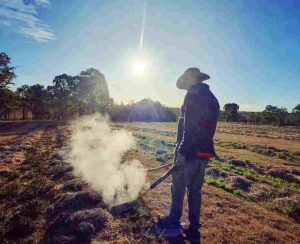Unmasking the True Costs of Chemical Weed Control: The Hidden Dangers You Can’t Ignore – Weed Warriors, It’s Time for a Safer Solution
Unveiling the Hidden Costs of Chemical Weed Control. Are you still just dodging the bullet?
Hey there, Weed Warriors! I know from so many hundreds of discussions with weed managers and technicians like you that organisations are still struggling to move away from chemical weed control because there is a perception that it’s the economic choice. I disagree. You only need one of the hidden costs to become monetized and the economics are flipped on its head. Today, let’s dive into the nitty-gritty of chemical weed control. Buckle up – it’s about to get real.
1. Potential Off-Target Oopsies and the Dreaded Lawsuit
Off-Target Oopsies:
So, you know how chemicals tend to go where they please? Doesn’t matter how careful you try to be, there are wiggles and run lines left in the grass, a little overspray onto the bedding plants, and who can control those pesky gusts of wind. Yeah, that often results in unintended plant casualties. Karen’s prize roses weren’t supposed to be collateral damage, but oops, they were. And guess what? Lawsuits might be heading your way.
2. Your Image Is Everything, Right?
Tarnished Public Image:
We get it; you’re all about saving the environment and being a sustainability superhero. It’s all right there in the Vision, Mission and Policies. But guess what damages that image? Widespread use of chemical weed killers. People frown upon it, and it might make you look like you’re not keeping up with your green promises.
3. Weeds: The Ultimate Survivors
Chemical Resistance:
Weeds are like the Rocky Balboas of the plant world. Hit them with the same chemical over and over, and they build resistance. Suddenly, you’re stuck in a never-ending battle, and those weeds just keep coming back stronger. So you mix a little of this with a little of that, increase the dosage and frequency and the costs keep going up, as well as the toxin load. And yet, they keep coming back. Rocky always wins!
4. Toxins on Main Street
Public Exposure to Toxins:
Let’s talk about safety. Chemical weed control means toxins in your public spaces. Not exactly what you signed up for, right? In the Main street, in playgrounds, in and around schools, in the plazas, it’s not cool. People are starting to care more about what they’re exposed to, and it’s more than raising some eyebrows.

Glyphosate, the active chemical used in products like Roundup, was classified by the IARC as probably carcinogenic to humans in 2015.
5. Safety First, but at What Cost?
Employee Health and Safety Costs:
Keeping your crew safe is a priority, no doubt. But using chemicals puts a dent in your budget with increased health and safety measures. Certifications, records, signage, it all starts piling up. We know, it’s a lot. And are they really following the labelled instructions?…. C’mon really? What is the lowest exposure that will result in a compensation lawsuit?
6. The No-Spray Zone Dilemma
Treating No-Spray Zones:
Handling the admin for areas where chemicals are a no-go in amongst areas you are still spraying? It’s like juggling flaming torches. The admin work is intense, and the resources required? Yeah, they add up. We get the struggle.
7. Stormwater Contamination Drama
Stormwater Contamination:
Interesting fact. ¼” of rain can remove up to 30% of glyphosate from a hard surface for up to a month after application. Ever thought about where all that re-diluted chemical runoff goes?
Spoiler alert: stormwater. It messes with water quality and is basically a not-so-cool plot twist for the environment. Who picks up the bill for the contaminated waterways and loss of froglets?
8. Biodiversity in Danger
Threat to Wildlife and Pets and it kills soil life:
Biodiversity starts in the soil and chems kill the soil life. All critters and pets deserve a safe haven, right? Chemical weed control messes with that harmony. Harm to wildlife, pets, soils and even beneficial insects? Not exactly the backyard vibe we’re aiming for. What’s the cost of lost biodiversity? Well it’s………..our future!
Alright, Weed Warriors, the struggle is real. But guess what?
There’s a revolution happening. Stay tuned as we spill the beans on how Weedtechnics and Satusteam™ are here to lead the way. It’s time for a greener, safer, and weed-free world. Ready for the lowdown on the solution? We thought so!
Jeremy Winer has 30 years of practical experience in implementing integrated holistic approach to organic weed management across urban landscapes, recreational parklands and wetlands. He currently runs Weedtechnics specialising in providing chemical reduction and non-toxic weed control programs to municipalities across Australia. He has developed, patented, manufactured, and commercialised the Steamwand method of creating saturated steam for vegetation control.
Labels
- The Top Hidden Costs of Chemical Weed Control or Toxic Weed control
- Harnessing the Power of Steam Weeding: A Sustainable Approach to Vegetation Management
- Did You Know Steam Weeding Can Actually Control Your Weed Seed Bank?
- Do Organic Herbicides Work?
- A Gardener’s Guide to Eco-Friendly Alternatives
- Ditch the Chemicals, Embrace Saturated Steam Weeding: A Safe and Effective Solution for Weed Control
- Transforming Park Facilities: Why Satusteam™ Is the Preferred Choice for Eco-Friendly Weed Management






